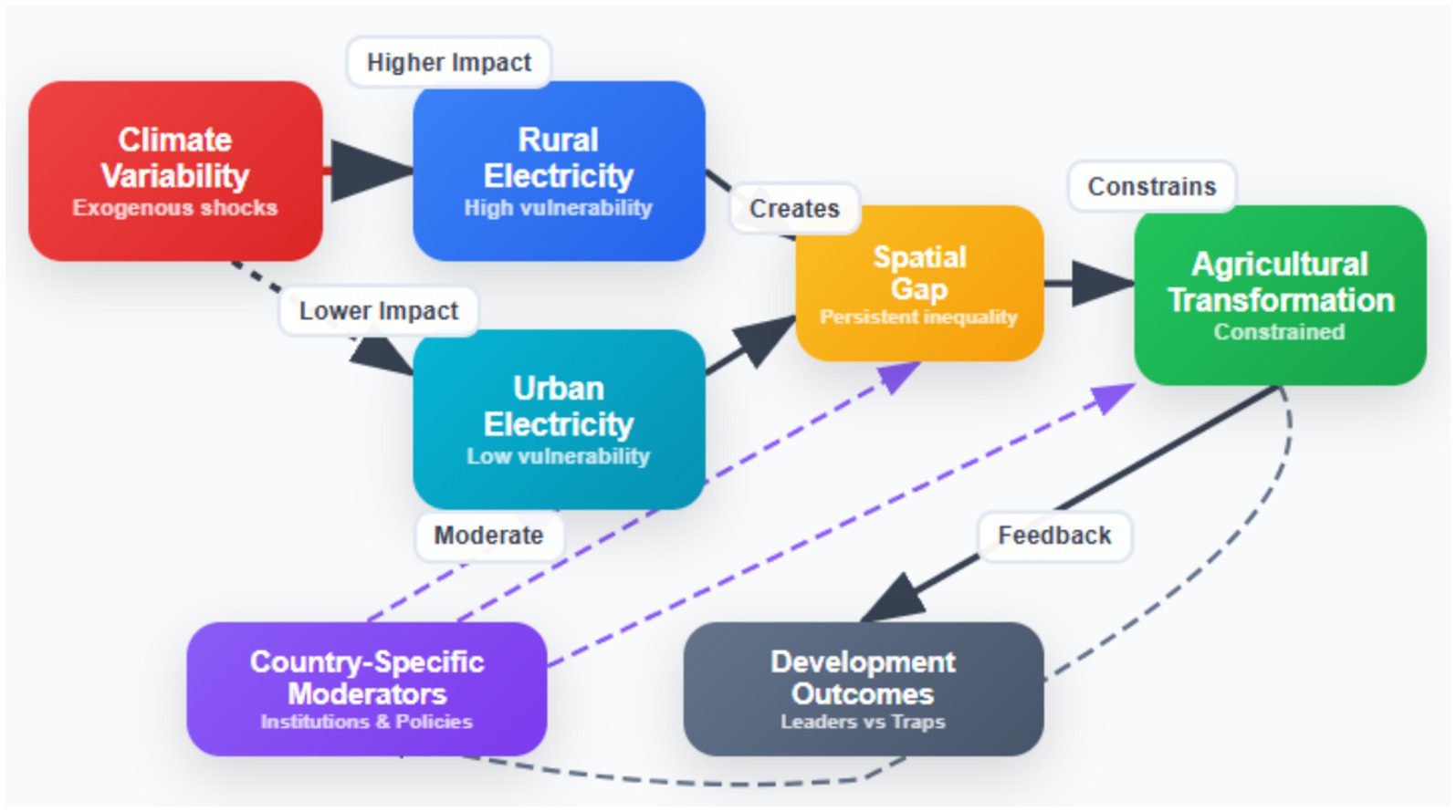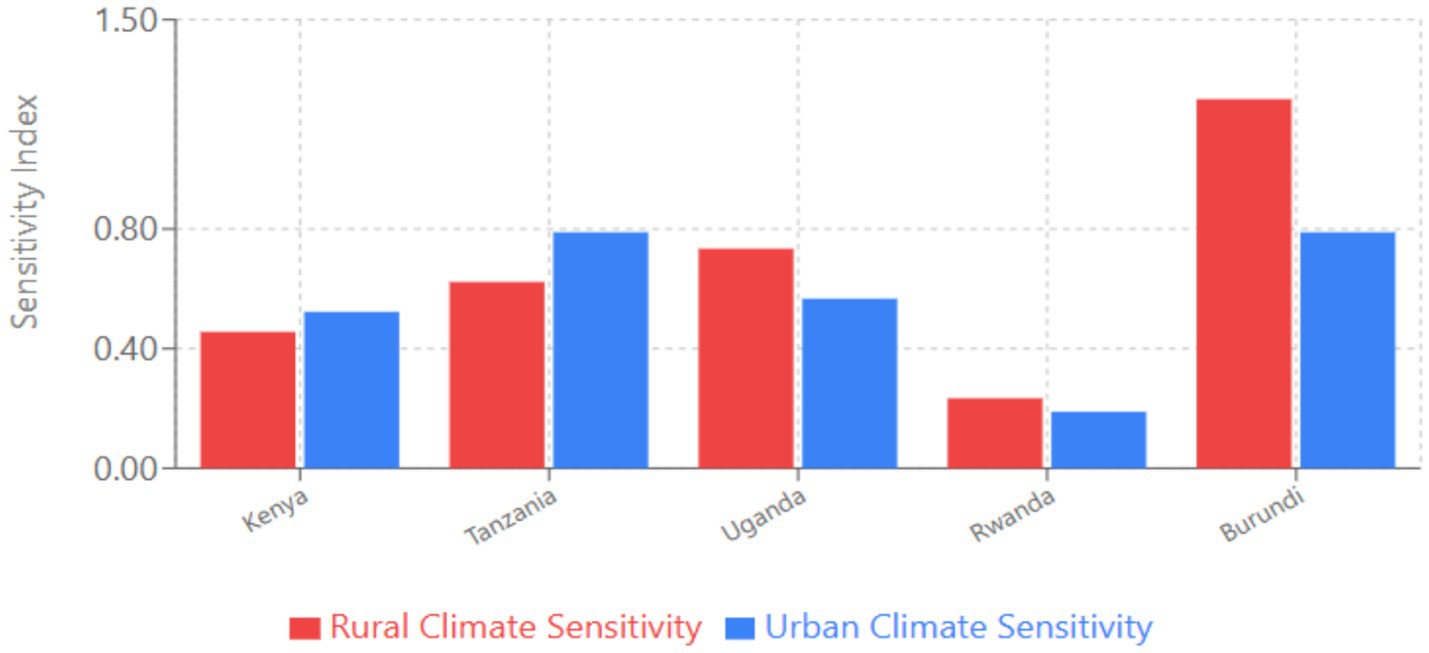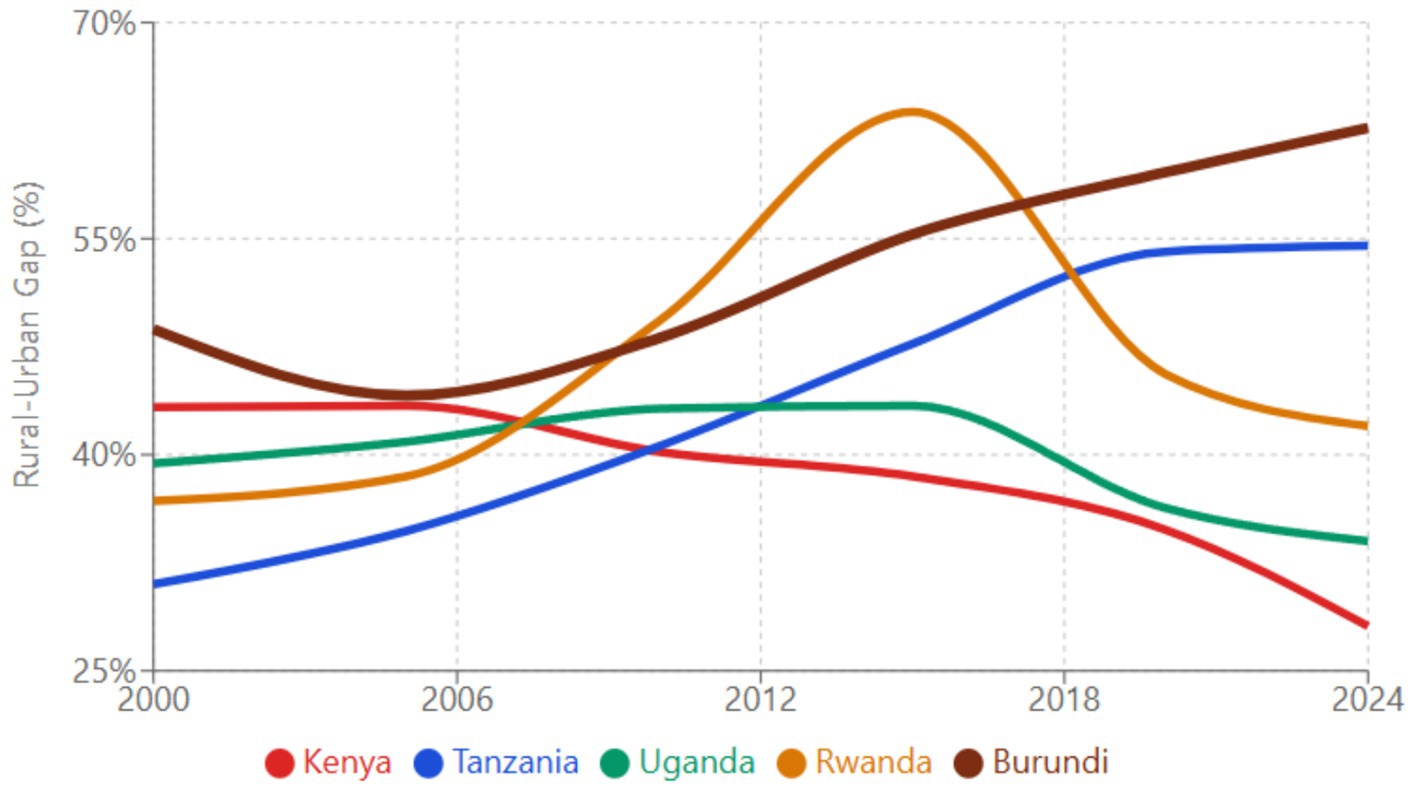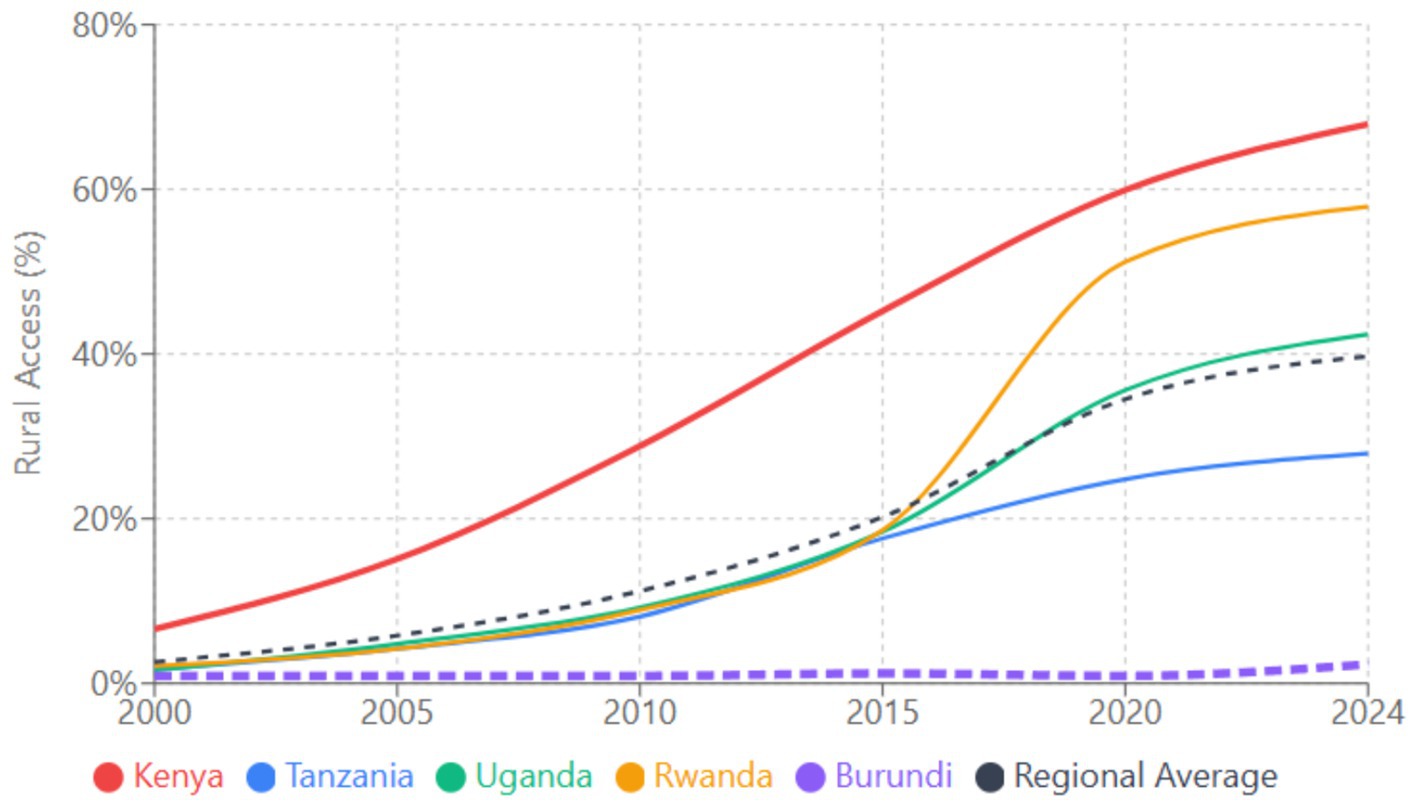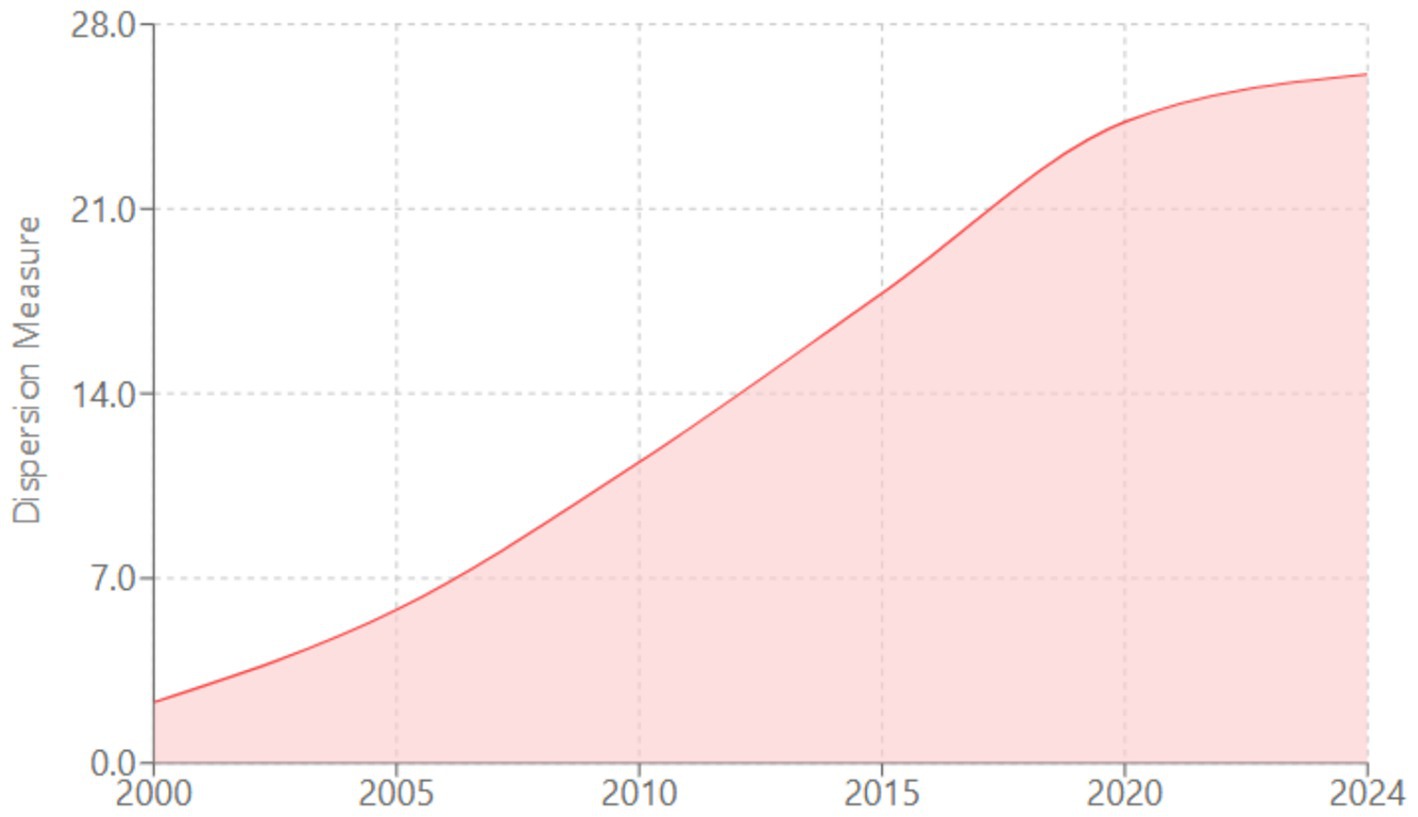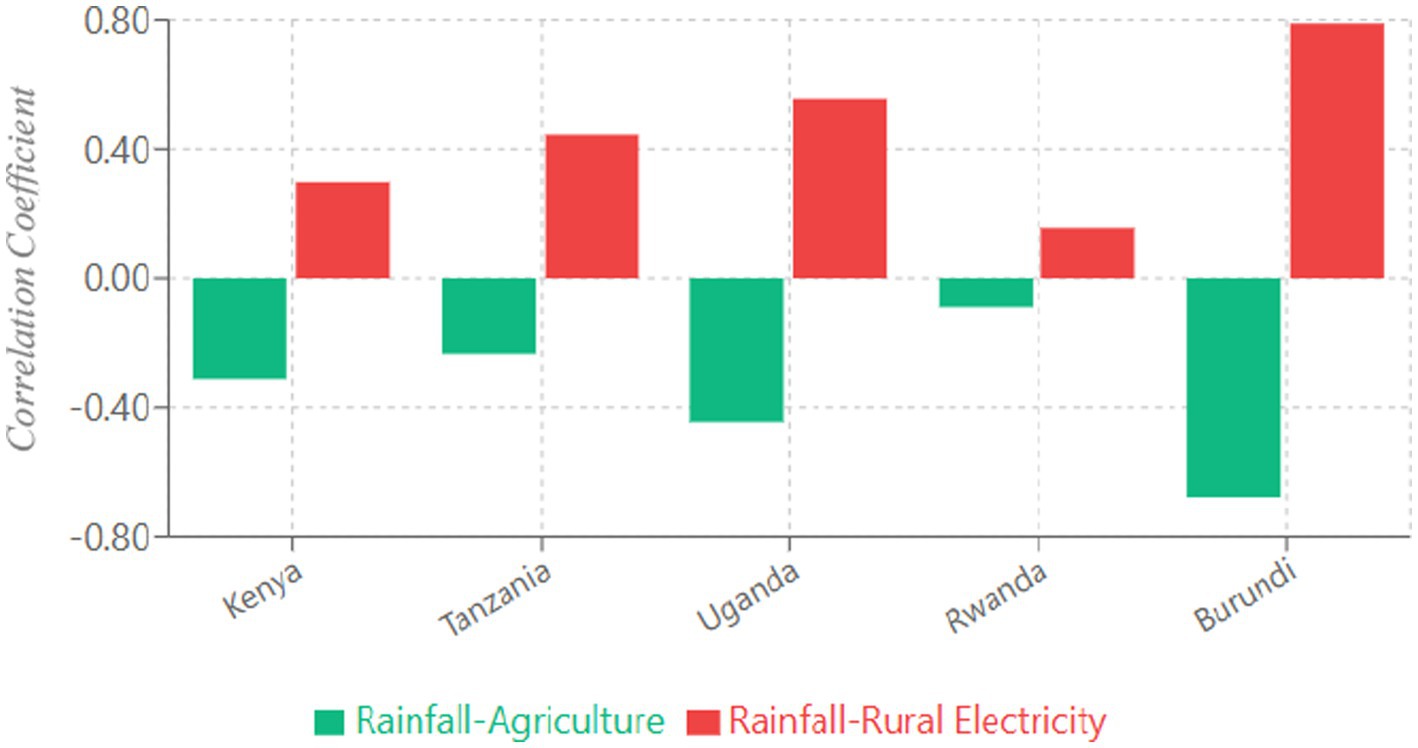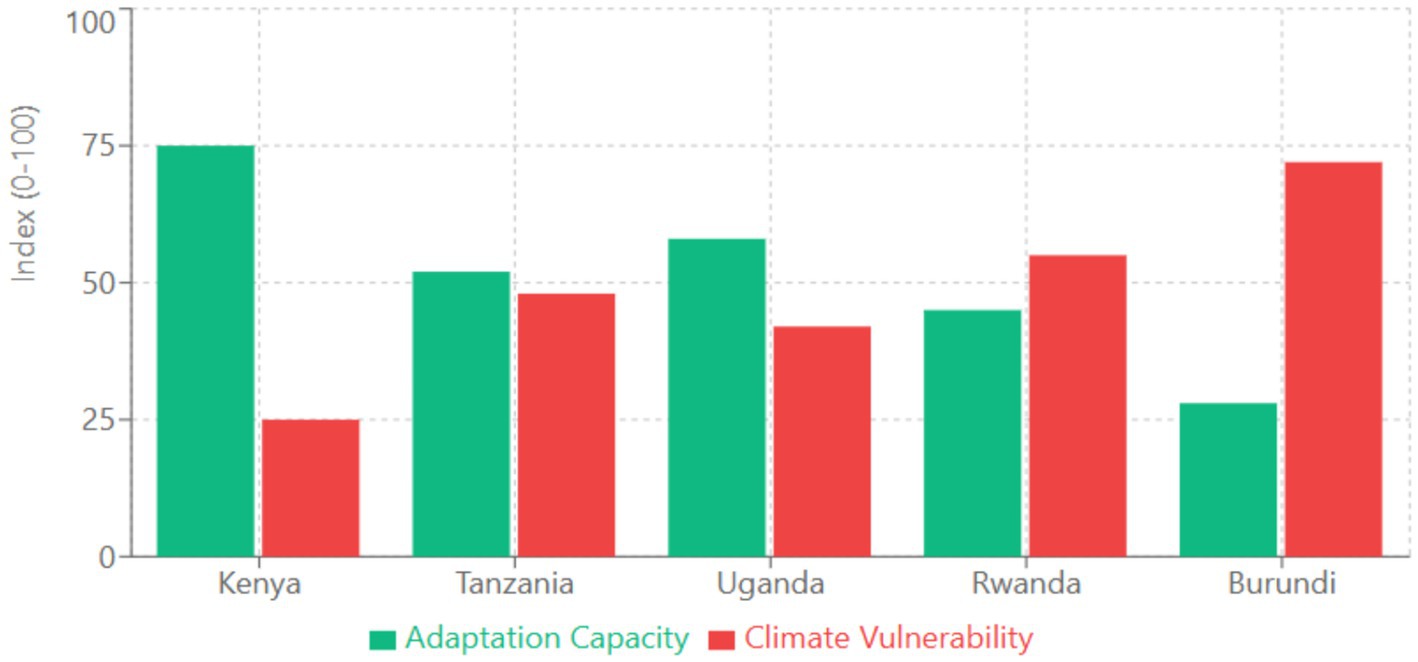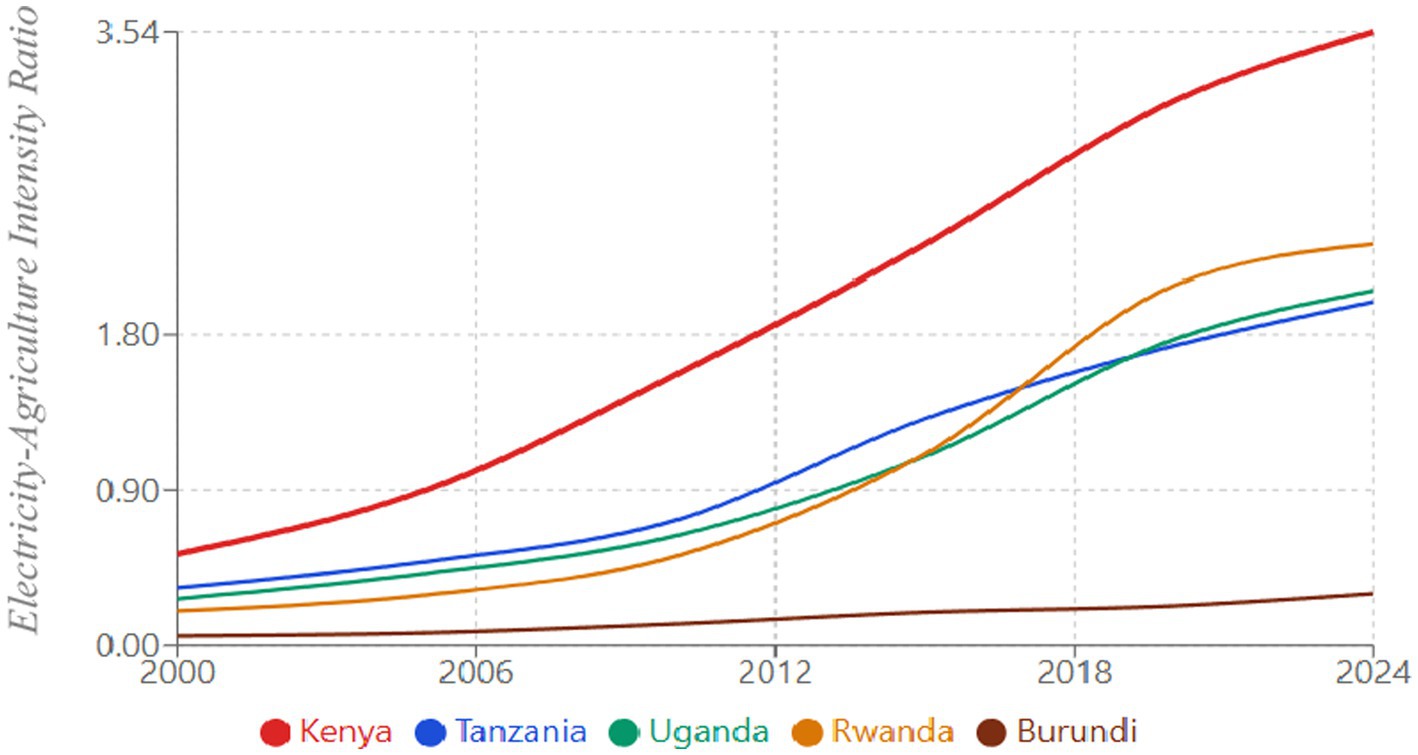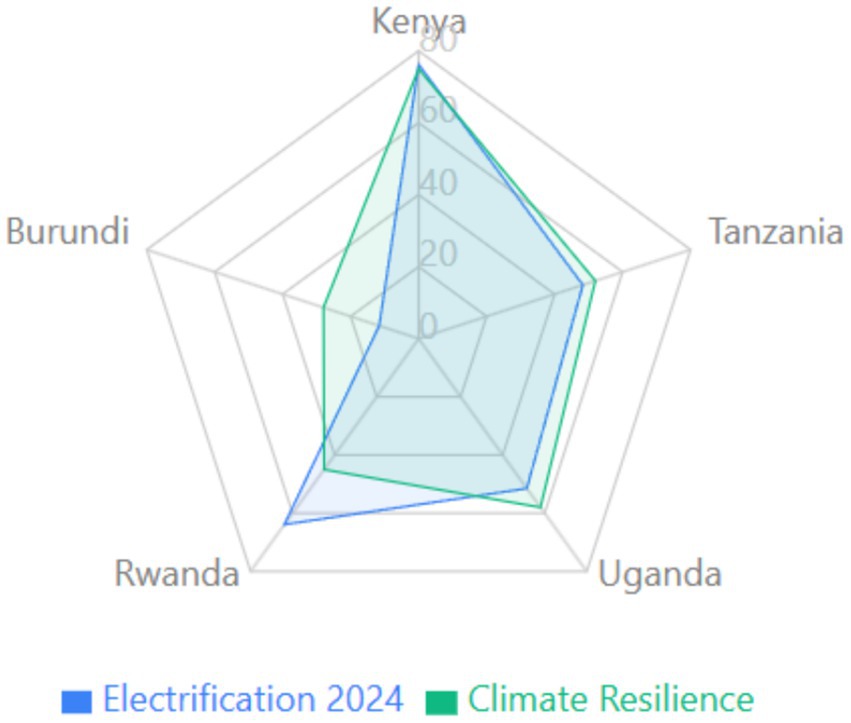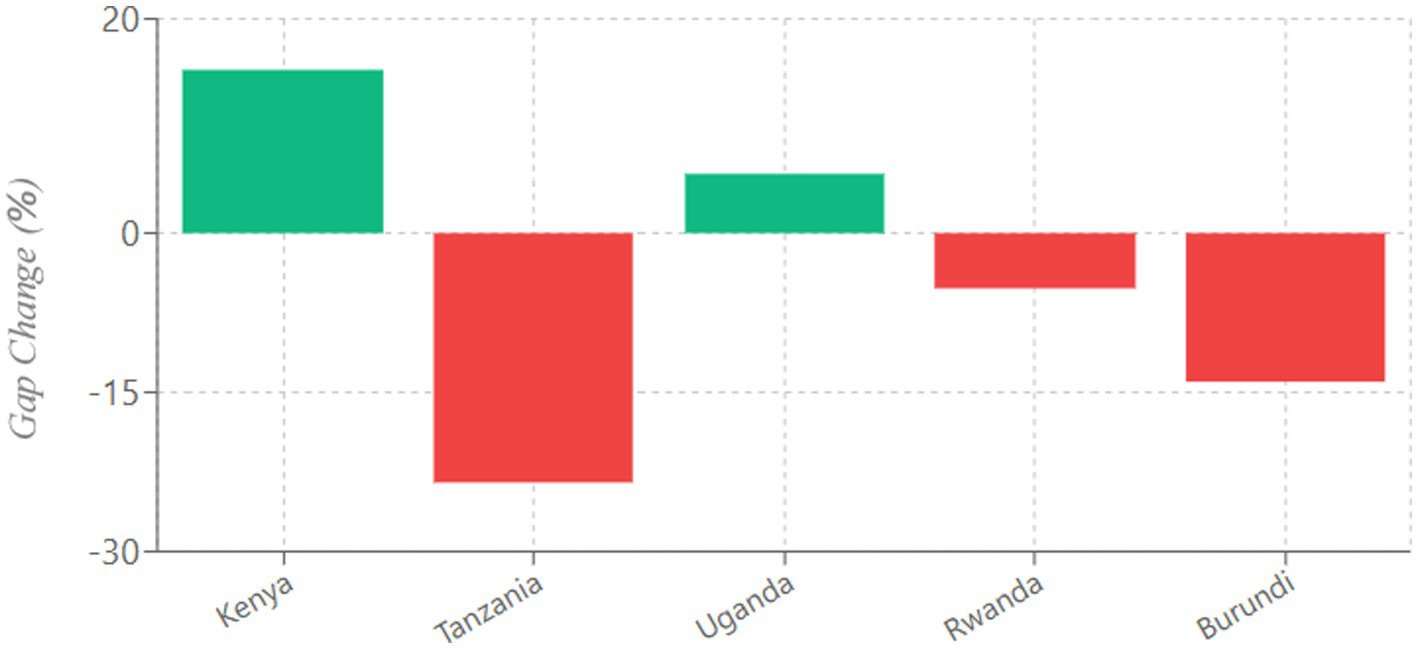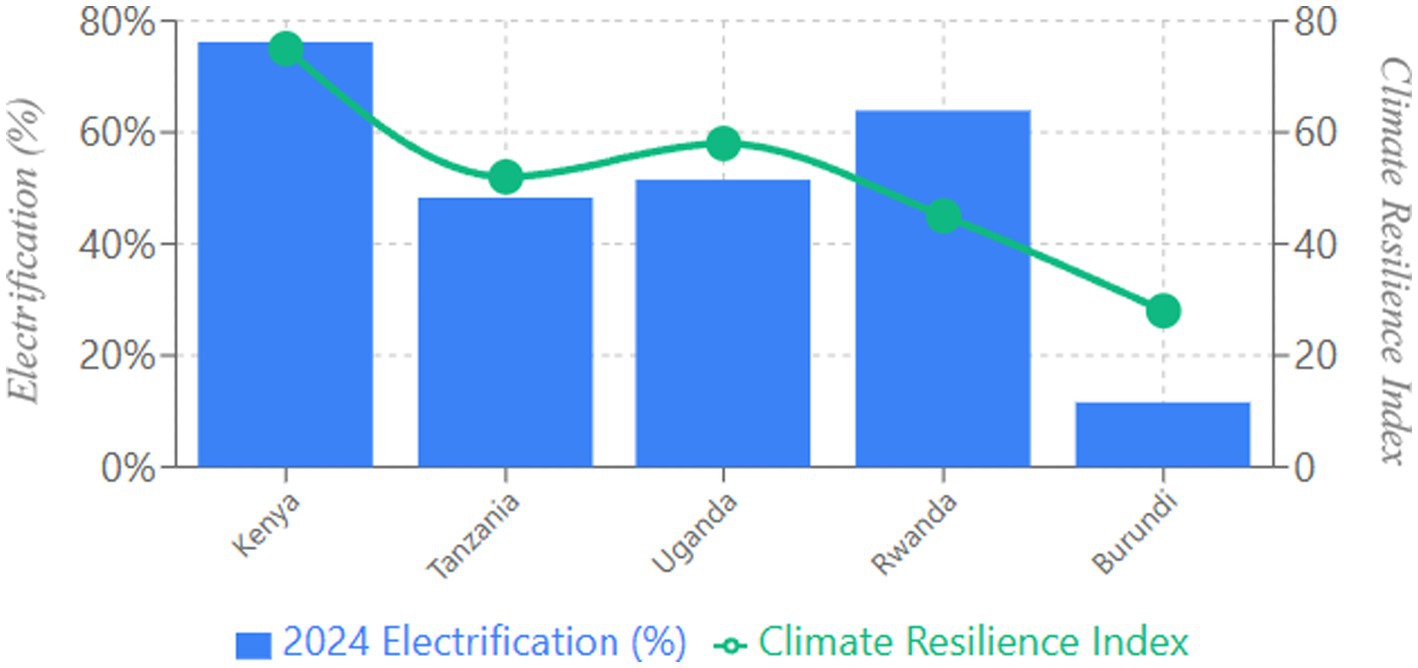- 1Faculty of Economics and Management Sciences, Hormuud University, Mogadishu, Somalia
- 2Department of Environmental Science, Faculty of Geoscience and Environment, Hormuud University, Mogadishu, Somalia
- 3Department of Environmental Science and Technology, Faculty of Forestry and Environment, Universiti Putra Malaysia, Serdang, Selangor, Malaysia
- 4Department of Mathematics, University of Manchester, Manchester, United Kingdom
This study investigates how climate variability affects rural and urban electricity access differently and how these disparities influence agricultural transformation in the East African Community. Based on a panel dataset covering Kenya, Tanzania, Uganda, Rwanda, and Burundi from 2000 to 2024, we apply climate anomaly analysis, correlation assessment, and performance indexing to explore the links between climate shocks, infrastructure vulnerability, and development outcomes. The results show that rural electricity systems are consistently more sensitive to climate fluctuations than urban ones, with vulnerability indices ranging from 0.234 in Kenya to 1.234 in Burundi. Rather than narrowing, rural–urban electricity gaps widened in most countries, most notably by 23.5 percent in Tanzania and 14 percent in Burundi, while Kenya made substantial progress, reducing its gap by 15.2 percent. Countries with larger electricity access gaps also showed stronger negative correlations between climate variability and agricultural output, including −0.678 in Burundi, highlighting the importance of reliable electricity in reducing climate impacts. In contrast, Kenya’s near-zero correlation suggests that improved electricity access can help buffer agricultural systems from climate stress. These findings highlight a growing adaptation gap, where rural communities, despite facing greater exposure to climate risks, are often the least equipped to respond due to limited access to reliable electricity and enabling infrastructure. The study underscores the need to treat electricity access not only as a development priority but as a vital form of climate adaptation, and calls for spatially targeted, climate-resilient infrastructure strategies to promote equitable and sustainable rural transformation.
1 Introduction
The intersection of climate variability, energy poverty, and agricultural transformation constitutes one of the most urgent development challenges in sub-Saharan Africa, where over 600 million people remain without electricity access, and rural livelihoods face growing threats from climate extremes (Bazilian and Pielke, 2013; Umair et al., 2024). This challenge is especially acute in East Africa, where agriculture remains the primary source of income for most households and is increasingly affected by unpredictable climate patterns, while rural electrification continues to lag significantly behind urban areas (Jessel et al., 2019; Zhao et al., 2025). The persistent rural–urban electricity divide not only perpetuates spatial inequality but may also undermine rural communities’ adaptive capacity to cope with accelerating climate impacts.
Recent empirical evidence suggests that rural electricity systems are more vulnerable to climate variability than urban infrastructure, due in part to design limitations, lower investment levels, and weaker institutional support (Hallegatte et al., 2018; Umair et al., 2024). This asymmetrical vulnerability carries serious implications for agricultural modernization, as reliable electricity access is now essential for deploying climate-resilient technologies such as irrigation, mechanization, and cold storage systems (Finizola e Silva et al., 2024; Okoronkwo et al., 2024). The influence of electricity on agriculture in rural areas extends beyond direct use in farming operations. Although most smallholders remain reliant on rainfall, access to electricity supports critical productive activities such as irrigation, milling, drying, and cold storage, which reduce losses and strengthen resilience to climate variability. Empirical evidence confirms this link as Amuakwa-Mensah and Surry (2022) find that rural electrcification is positively associated with agricultural output across Sub-Saharan Africa, while Dagnachew et al. (2023) emphasize that energy planning in the region must explicitly include productive and agricultural uses of electricity. These findings reinforce the view that rural electrification serves as an enabling adaptation infrastructure, supporting agricultural transformation and climate resilience rather than substituting renewable energy technologies.
While energy access inequality and climate risks are well documented in East Africa, few empirical studies explicitly connect these dimensions within the East African Community (EAC). Existing research largely examines either infrastructure vulnerability to climate variability or structural patterns of access inequality, but not their interaction. For instance, Sridharan et al. (2019) model how climate change affects hydropower reliability and energy security across the Eastern African Power Pool, while Mulyanyuma et al. (2024) document how recurrent droughts and floods disrupt electricity generation and transmission in Uganda, Kenya, and Tanzania. Likewise, Idanegbe et al. (2024) and Nik et al. (2021) show that African and global studies on energy resilience emphasize system stress and adaptation but rarely include spatial disaggregation by rural and urban areas. Complementary reviews by Blimpo et al. (2024) and Kuusaana et al. (2025) highlight policy and institutional dimensions of electricity resilience in Africa yet find limited quantitative work linking climate shocks to access disparities. Collectively, this literature demonstrates that, although both climate vulnerability and energy inequality are recognized challenges, their combined spatial dynamics remain understudied in the EAC context.
Hence, this study examines the interaction between climate stress, rural–urban electrification disparities, and agricultural transformation within the East African Community. In this context, climate stress refers to the pressures exerted on energy and production systems by variability in temperature and rainfall, which are modeled through climate sensitivity coefficients to capture how changes in these variables influence electricity access and agricultural performance. Rural–urban electrification disparities represent the persistent difference in household electricity access between urban and rural areas, expressed as the absolute gap in electrification rates across time and countries. Agricultural transformation describes the ongoing shift toward higher productivity and more energy-dependent agricultural systems, reflected in improvements in agricultural value added and the integration of electricity in irrigation, processing, and storage. Together, these concepts form the basis for understanding how climate variability can reinforce or reduce spatial inequality and influence the trajectory of agricultural change in the region.
While development theory generally anticipates long-run convergence in infrastructure access, emerging evidence indicates that this pattern is not guaranteed. In the context of energy access, rural areas are expected to gradually catch up with urban centers as electrification expands. However, climate-related shocks, weak institutional capacity, and uneven policy focus often disrupt this process, reinforcing spatial inequality instead (Hallegatte et al., 2018; Sun et al., 2024; Zhao et al., 2025). This study examines these dynamics empirically, assessing how climate variability interacts with rural–urban electrification gaps across the East African Community. This divergence is particularly consequential for the estimated 365 million people across Eastern and Southern Africa still living without electricity, many of whom reside in rural regions most exposed to climate hazards (International Energy Agency (IEA), 2020; World Bank, 2024a). In addition to environmental and institutional factors, political stability remains a critical determinant of infrastructure development. Countries such as Burundi illustrate how prolonged political and economic fragility can suppress investment and disrupt energy access expansion, further amplifying climate and development vulnerabilities (World Bank, 2024b).
The motivation for this research lies in the growing need to understand how climate variability influences infrastructure performance and development outcomes in vulnerable regions. Current electrification strategies often assume climatically neutral infrastructure rollouts, overlooking the role of environmental stress in shaping spatial patterns of access and resilience. Acknowledging the compounding effects of climate on spatial development is essential to formulating policies that simultaneously expand energy access, enhance adaptive capacity, and support agricultural transformation (Bazilian and Pielke, 2013; Hallegatte et al., 2018).
This study empirically examines the climate-electricity-agriculture nexus in five EAC countries Kenya, Tanzania, Uganda, Rwanda, and Burundi, spanning the years 2000 to 2024. It tests four interrelated hypotheses concerning rural climate vulnerability, spatial divergence, agricultural development constraints, and the buffering role of electricity against climate impacts. Through the integration of climate science, energy policy, and agricultural economics, this research offers new insights into how climate-induced infrastructure fragility produces compounding disadvantages for rural populations.
This study makes two principal contributions to the existing literature. First, it provides a cross-national, longitudinal analysis of how climate variability differentially affects rural and urban electricity systems across the East African Community. Second, it advances the conceptualization and empirical validation of electricity as a form of climate adaptation infrastructure, positioning energy access not merely as a development input, but as a foundational mechanism for building resilience. While prior research has documented the general benefits of electrification, (Dinkelman, 2011; Lee et al., 2020), and outlined key principles of adaptation planning (Thornton and Herrero, 2014), this study addresses a critical gap by examining how climate variability mediates spatial disparities in energy access and evaluating whether dominant electrification strategies remain robust under climate stress.
2 Literature review
The intersection of climate variability, electricity access, and agricultural transformation represents a critical research frontier for sub-Saharan Africa. This region faces a dual burden which are chronic energy poverty and intensifying climate risks, both of which disproportionately affect rural populations that depend on rain-fed agriculture and lack reliable infrastructure (Bazilian and Pielke, 2013; Umair et al., 2024). These interlinked challenges fundamentally shape development trajectories, particularly where adaptation capacity is constrained by uneven access to essential services.
Rural areas remain structurally disadvantaged in terms of electrification, receiving fewer investments than urban centers despite facing higher climate exposure (Jessel et al., 2019; Zhao et al., 2025). Such spatial inequalities in infrastructure provision undermine adaptive capacity and exacerbate vulnerability, challenging traditional convergence theories that predict narrowing regional disparities over time. Recent studies demonstrate that climate shocks can instead reinforce divergence, particularly where institutions are weak or biased toward urban priorities (Cai et al., 2024).
Electricity access is increasingly recognized as critical for enabling climate-smart agriculture (CSA). Electrification supports essential adaptive technologies such as irrigation, cold storage, and mechanized processing, which reduce vulnerability to climate shocks (Okoronkwo et al., 2024; Thornton and Herrero, 2014). Finizola e Silva et al. (2024) emphasize that while farmer education enhances CSA adoption, access to energy infrastructure mediates whether knowledge translates into practice. Similarly, Makate et al. (2019) show that multiple CSA strategies improve resilience among smallholders, but their effectiveness depends on energy availability and affordability.
Beyond the technical functions of electrification, energy access supports broader dimensions of adaptive capacity, including digital connectivity, financial inclusion, and access to climate information (Blimpo and Cosgrove-Davies, 2019; Mhlanga and Ndhlovu, 2023). However, the benefits of distributed energy systems like mini-grids and solar home systems are uneven. While they offer promise for rural transformational progress, their limitations in reliability, scale, and productive use hinder widespread transformation (Carabajal et al., 2024).
Climate change also interacts with longstanding agricultural vulnerabilities. Agyekum et al. (2024) and Omotoso et al. (2023) document how shifting climate patterns intensify the risks to food security, labor productivity, and income stability in African agriculture. These impacts are even greater when adaptation infrastructure, such as electricity, is inadequate or unevenly distributed. At the same time, vulnerable agricultural systems often struggle to support the very investments needed to strengthen that infrastructure. Low farm incomes, weak rural markets, and limited public resources can all make it harder to expand or maintain energy systems. As a result, poor infrastructure and agricultural vulnerability feed into each other, creating a cycle that deepens both exposure and inequality (Cai et al., 2024; Hallegatte et al., 2018).
The effectiveness of CSA programs is also shaped by governance and institutional alignment. Chevallier (2023) highlights that while African policy frameworks increasingly recognize energy-agriculture-climate linkages, implementation is often hampered by fragmented coordination. Djido et al. (2021) add that weather and climate information services can promote CSA uptake, but only when coupled with energy and financial services that enable action.
Despite the growing policy and academic recognition of electricity as a form of adaptation infrastructure, few empirical studies have explored how climate variability differentially affects rural versus urban electricity systems. Even fewer assess whether improved electricity access buffers agricultural output from climate shocks or whether spatial gaps are narrowing or widening over time.
This study fills three critical gaps. First, it examines whether climate variability generates differential impacts on rural versus urban electricity systems. Second, it investigates whether these disparities constrain agricultural modernization and exacerbate spatial inequality. Third, it assesses whether electricity access moderates climate-agriculture interactions, framing electricity as not only a development input but also a core adaptation mechanism. Addressing these questions requires a spatially and temporally disaggregated analysis, an approach this study applies to five East African Community members over the period 2000–2024.
2.1 Theoretical review
This study is grounded in development theory, particularly the convergence hypothesis, which posits that poorer or less-developed regions should experience faster growth than wealthier ones as capital, technology, and infrastructure diffuse over time (Barro and Sala-i-Martin, 1992; Solow, 1956). Under this framework, infrastructure such as electricity access is expected to converge across regions as investment expands and institutions mature. However, recent studies suggest that convergence is not automatic. External shocks, including climate variability, and differences in institutional capacity can slow or even reverse convergence trends (Hallegatte et al., 2018; Zhao et al., 2025).
This theoretical lens provides the foundation for examining whether climate stress contributes to divergence in electricity access within the East African Community. By assessing how changes in temperature and rainfall influence rural–urban electrification patterns and agricultural transformation, the study tests the extent to which climate-sensitive infrastructure dynamics align with or deviate from the expectations of convergence theory.
2.2 Conceptual framework
The conceptual framework in Figure 1, illustrates the theoretical relationships between climate variability, electricity infrastructure, and agricultural transformation that guide our empirical investigation in East African Community members.
Unlike standard development theory, which assumes that infrastructure and economic growth follow relatively linear and climate-neutral paths toward convergence (Barro and Sala-i-Martin, 1992; Solow, 1956), the literature informing this framework emphasizes the disruptive role of climate variability and institutional capacity. Recent studies argue that environmental stress can reshape or even reverse expected development trajectories by amplifying existing inequalities in access to infrastructure and adaptive resources (Chevallier, 2023; Hallegatte et al., 2018; Zhao et al., 2025). This perspective shifts the focus from purely economic accumulation to resilience and adaptive capacity, highlighting how climate shocks interact with governance and energy systems to produce either convergence or divergence in agricultural transformation outcomes.
The framework proposes that climate shocks create differential impacts on rural versus urban electricity systems due to fundamental infrastructure and institutional differences, leading to persistent spatial gaps that constrain agricultural transformation and rural adaptive capacity. The core theoretical logic suggests that rural electricity infrastructure will demonstrate higher climate sensitivity than urban systems because of design limitations, maintenance constraints, and investment priorities that favor urban areas.
The framework anticipates that these differential climate vulnerabilities will create or widen rural–urban electricity gaps over time, rather than the convergence predicted by standard development theory. These spatial inequalities are expected to constrain agricultural transformation by limiting rural communities’ access to adaptation technologies such as irrigation, processing, and mechanization that require reliable electricity. Country-specific factors, including institutional capacity, policy frameworks, and geographic characteristics, are theorized to moderate these relationships, explaining potential variation in outcomes across EAC members. The framework also incorporates feedback mechanisms where agricultural productivity improvements could generate resources for infrastructure investment, creating either virtuous development cycles or poverty traps depending on initial conditions and institutional capacity.
2.3 Research hypotheses
Based on our theoretical framework, we propose four core hypotheses examining the climate-electricity-agriculture nexus in East African Community members:
Hypothesis 1 (H1): Rural Climate Vulnerability. Rural electricity systems demonstrate significantly higher climate sensitivity than urban electricity systems due to infrastructure design differences and lower investment priority.
Hypothesis 2 (H2): Spatial Gap Dynamics. Climate variability creates or widens rural–urban electricity gaps over time rather than promoting convergence, with countries experiencing greater climate stress developing larger spatial disparities.
Hypothesis 3 (H3): Agricultural Transformation Constraints. Larger rural–urban electricity gaps constrain agricultural transformation by limiting rural access to adaptation technologies that require reliable electricity infrastructure.
Hypothesis 4 (H4): Electricity as Climate Buffer. Countries with better electricity access demonstrate weaker correlations between climate variability and agricultural performance, indicating electricity’s role as climate adaptation infrastructure.
3 Methodology
3.1 Data and study design
We analyze panel data from five East African Community members (Kenya, Tanzania, Uganda, Rwanda, and Burundi) spanning 2000–2024 to test four hypotheses about climate-electricity-agriculture interactions. The methodology combines climate anomaly analysis, correlation assessment, and performance indexing to examine how climate variability differentially affects rural versus urban electricity systems and constrains agricultural transformation. Our identification strategy leverages climate anomalies as exogenous shocks to establish causal relationships between infrastructure vulnerability, spatial gaps, and development outcomes. The original variables used in constructing our key measures include rural electricity access (ELCR), urban electricity access (ELCU), total electricity access (ELC), annual rainfall (RFL), annual temperature (TMP), and agriculture as a percentage of GDP (AGR). Electricity access and economic indicators were obtained from the World Bank’s World Development Indicators (WDI), while rainfall and temperature data were sourced from Our World in Data.
3.2 Variable construction
Rural–Urban Electricity Gap is the core dependent variable measuring spatial disparities.
where RUGit represents the rural–urban gap, ELCUit urban electricity access, and ELCRit rural electricity access for country i in year t.
Gap closure performance is measured as:
where positive values indicate successful closure.
Climate variability is measured through anomalies calculated as deviations from country-specific historical means:
where T represents 25 years. This approach captures climate deviations while controlling for systematic cross-country differences. Rainfall and temperature variability affect electricity access primarily through their impact on hydropower generation and grid reliability. In the East African context, reduced rainfall lowers inflows to reservoirs and limits generation, while extreme rainfall can damage transmission systems and disrupt distribution (Sridharan et al., 2019; Wei et al., 2020). Rising temperatures intensify evaporation losses from reservoirs and reduce generation efficiency, while higher cooling demand in urban areas can strain grids and reduce rural supply reliability (International Energy Agency (IEA), 2020). These mechanisms justify using rainfall and temperature as proxies for climate stress on electricity systems in this study.
Climate sensitivity indices quantify the strength of relationships between climate anomalies and electricity access indicators using Pearson correlation coefficients calculated separately for rural and urban electricity access:
Where r represents the Pearson correlation coefficient and absolute values ensure positive sensitivity measures regardless of correlation direction. The rural vulnerability index is calculated as the difference between rural and urban climate sensitivity:
Positive values indicate rural electricity access is more climate-sensitive than urban access within country i, while negative values indicate urban areas are more climate-sensitive. This measure provides a standardized indicator of within-country spatial differences in climate vulnerability.
Agricultural transformation is measured through: (1) Declining agricultural GDP shares:
and (2) Electricity-Agriculture Intensity ratios:
where rising ratios indicate faster electrification relative to agricultural decline.
3.3 Analytical methods
The analytical framework employs multiple complementary approaches to examine climate-electricity-agriculture interactions while addressing potential endogeneity and measurement concerns.
3.3.1 Trend analysis and temporal patterns
Temporal trend analysis employs country-specific linear regression models to identify systematic changes in key variables over the study period:
where Yit represents the outcome variable, αi captures country-specific intercepts, βi represents country-specific trend coefficients, and Ɛit is the error term. This specification allows for heterogeneous temporal patterns across countries while controlling for unobserved country characteristics through fixed effects.
Gap evolution analysis utilizes this framework to test for systematic convergence or divergence patterns:
where negative βi coefficients indicate gap closure over time while positive coefficients indicate gap widening. Cross-country variation in trend coefficients tests convergence hypotheses.
3.3.2 Climate-electricity correlation analysis
Climate-electricity relationships are quantified through Pearson correlation analysis with robust standard errors to account for potential heteroskedasticity and temporal correlation. The correlation estimation follows a two-stage procedure to separate climate effects from broader development trends:
Stage 1: Detrending
Stage 2: Correlation of Residuals
This approach isolates climate-electricity relationships from systematic development trends that might spuriously inflate correlation estimates. Partial correlations control for agricultural transformation, GDP growth, and renewable energy transitions to ensure robustness. Both Pearson and Spearman correlations are calculated to verify results are not driven by outliers or non-linear relationships.
3.3.3 Performance evaluation and cross-country comparison
Country performance evaluation employs standardized indices that enable comparison across different measurement scales and baseline conditions. Each performance indicator is standardized using z-score transformations:
Composite performance indices aggregate multiple standardized indicators using equal weighting:
where n represents the number of indicators and j indexes different performance dimensions. This approach ensures that no single indicator dominates composite measures while maintaining interpretability through standardization. Rankings are validated through alternative weighting schemes and principal component analysis to ensure robustness.
3.3.4 Regional convergence testing
Regional convergence is tested through standard deviation calculations of rural electricity access rates across countries for each year:
where N represents the number of countries (5) and ELCRt represents the regional average rural electricity access in year t. Decreasing t over time indicates sigma-convergence, while increasing values suggest divergence.
Beta-convergence is tested through cross-sectional regression of electricity access growth rates on initial levels:
Where ΔELCRᵢ represents the average annual growth rate from 2000–2024. Negative β coefficients indicate convergence (countries with lower initial access experience faster growth).
3.3.5 Climate-agriculture interaction models
To examine climate adaptation mechanisms, we estimate climate-agriculture relationships conditional on electricity access levels:
where the interaction term β2 captures how electricity access moderates, climate impacts on agriculture. γXit includes control variables such as GDP per capita, population density, and time trends. This specification tests whether electricity access serves as climate adaptation infrastructure by buffering agricultural systems from climate variability.
3.4 Data quality
Missing observations (4% electricity, under 2% climate) are addressed through linear interpolation for electricity data and country-specific means for climate variables. All variables undergo validation with realistic ranges, and identified anomalies are corrected based on regional patterns.
4 Results
4.1 Rural climate vulnerability patterns
Our climate sensitivity analysis reveals striking differences in how rural and urban electricity systems respond to climate shocks across East African Community members. Rural electricity infrastructure demonstrates consistently higher vulnerability to climate variations, with sensitivity indices ranging from moderate levels in Kenya to extreme vulnerability in Burundi.
Figure 2 illustrates the systematic pattern of rural climate vulnerability across all five EAC countries studied. Burundi exhibits the most severe rural vulnerability with a climate sensitivity index of 1.234, indicating that rural electricity access fluctuates more than twice as much with climate variations compared to urban areas. Kenya shows the lowest rural vulnerability, reflecting more resilient infrastructure design and better institutional support systems. The consistent pattern across countries, where rural systems invariably show higher climate sensitivity than urban counterparts, provides strong evidence for our first hypothesis that infrastructure design and institutional differences create systematic spatial vulnerabilities.
4.2 Spatial gap evolution and divergence
Contrary to expectations from convergence theory, rural and urban electricity access in the East African Community has followed sharply different paths over the past two decades. Instead of converging toward equality, member states have experienced widening or uneven gaps that mirror deeper institutional and policy contrasts.
Figure 3 highlights this divergence clearly. Kenya stands out as the only country that has achieved sustained convergence, with a 15.2-percentage-point reduction in its rural–urban electricity gap. This progress reflects the consistent implementation of coordinated rural electrification initiatives, including the Last Mile Connectivity Project and the policy reforms introduced through the Energy Act of 2019, which strengthened regulation and financing for low-income and remote communities (AfDB, 2014; Republic of Kenya, 2019). In contrast, Tanzania’s experience shows how ambitious plans can stall without aligned funding and institutional coordination. The country’s Rural Energy Agency framework and electrification master plan faced recurring resource shortages and implementation delays, limiting the pace of rural access expansion despite widespread grid coverage (World Bank, 2024a).
Other EAC members have shown mixed results. Burundi recorded a 14-percentage-point widening of its gap, while Tanzania’s increased by 23.5 points. Burundi’s prolonged political instability and structural economic fragility have constrained public investment and weakened institutional capacity, limiting progress in electrification and resilience-building (World Bank, 2024b). Uganda and Rwanda made modest progress, though their trends remain uneven.
Rwanda’s pattern in Figure 3 stands out from the other countries. While overall access to electricity has grown steadily, the rural–urban gap has fluctuated rather than closing consistently. This reflects the sequencing of national electrification efforts, where early phases focused on rapid grid expansion in urban areas, while rural access relied more on smaller, donor-supported off-grid projects that progressed unevenly. Government plans under the Energy Sector Strategic Plan aimed to combine these two approaches, yet implementation delays and funding gaps occasionally slowed rural gains (Ministry of Infrastructure (MININFRA), 2018; Tomei and Gent, 2015). These shifts help explain why the gap widened temporarily even as national access improved.
These outcomes suggest that institutional capacity alone is not enough; deliberate and sustained policy attention to spatial equity is essential to ensure that electrification benefits reach rural populations consistently.
4.3 Regional electricity access divergence
The cumulative effect of these different trajectories has created unprecedented inequality in rural electricity access across EAC members by 2024, challenging fundamental assumptions about regional integration and shared development. Figure 4 demonstrates the dramatic widening of rural electricity access disparities across the region. The spread between Kenya’s 67.9% rural access rate and Burundi’s dismal 2.3% represents a staggering 65.6 percentage point gap—a level of inequality that extends far beyond simple infrastructure differences to reflect fundamental variations in development capacity. This systematic divergence over time, shown by the increasing dispersion of country performance, provides compelling evidence against automatic convergence assumptions and highlights how initial advantages or disadvantages can become self-reinforcing without deliberate intervention.
The quantitative analysis of regional dispersion confirms this divergence pattern. Figure 5 shows the coefficient of variation in rural electricity access rates increasing systematically from 2000 to 2024, providing statistical evidence that countries are not converging but rather following “club divergence” dynamics where strong institutional performers pull ahead while weaker states fall further behind. This challenges fundamental assumptions in development economics about automatic convergence and suggests that without deliberate intervention, spatial inequalities become self-reinforcing rather than self-correcting.
4.4 Climate-agriculture interactions and adaptation
The relationship between climate variability and agricultural output varies dramatically across EAC members, with electricity access playing a crucial moderating role that demonstrates its function as climate adaptation infrastructure.
Figure 6 reveals how electricity access serves as a buffer against climate impacts on agriculture. Countries with better rural electrification, exemplified by Kenya, show weak correlations between climate variability and agricultural output, suggesting that reliable electricity enables farmers to adapt to climate shocks through irrigation, storage, processing, and other technologies. Burundi represents the opposite extreme, with a strong negative correlation of −0.678 between rainfall and agricultural output, reflecting the compound vulnerabilities facing farmers without access to basic adaptation infrastructure.
The adaptation capacity analysis in Figure 7 reveals stark contrasts in countries’ ability to use electricity infrastructure for climate resilience. Burundi exhibits the lowest rural adaptation capacity (28 index points) combined with the highest climate vulnerability (72 points), while Kenya demonstrates the highest adaptation capacity (75 points) with the lowest vulnerability (25 points). This inverse relationship validates arguments that energy infrastructure must be coupled with adequate institutional capacity to yield effective adaptation outcomes, with electricity serving not merely as a development input but as critical climate adaptation infrastructure.
4.5 Agricultural transformation and electricity integration
The relationship between electricity access and agricultural modernization reveals systematic patterns that support our theoretical framework about infrastructure-enabled transformation.
Figure 8 shows the electricity-agriculture intensity ratio trajectories across EAC members from 2000 to 2024. Kenya demonstrates a steep upward trajectory indicating successful integration of electricity into farming systems and agricultural modernization. In contrast, Burundi’s flat trajectory reflects persistent energy poverty that constrains both agricultural mechanization and economic diversification. The divergent patterns provide compelling evidence that electricity access is essential for agricultural transformation and structural economic change, supporting our third hypothesis about infrastructure constraints on rural development. Synthesizing performance across multiple dimensions reveals distinct country typologies that capture the complex interactions between electrification progress, climate resilience, and agricultural transformation outcomes.
Figure 9 presents a comprehensive assessment of country performance across four key dimensions: electrification progress, gap closure effectiveness, climate resilience, and agricultural transformation. Kenya emerges as the clear regional leader, demonstrating superior performance across all dimensions through coordinated policy interventions and sustained institutional commitment. Burundi occupies the opposite position, trapped in compound disadvantages across all performance measures. Uganda and Rwanda show mixed results with moderate progress in some areas but continued challenges in others, while Tanzania’s intermediate position masks concerning deterioration in spatial equity despite reasonable overall electrification progress.
The detailed analysis of gap closure effectiveness in Figure 10 illustrates the dramatic variation in rural–urban electricity gap performance across EAC members. Kenya’s gap closure effectiveness (15.2 percentage points) stands in stark contrast to Tanzania’s deterioration (23.5 percentage points), highlighting how different policy approaches and institutional capacities produce dramatically different outcomes even among countries facing similar geographic and climatic challenges. This demonstrates the critical importance of deliberate policy intervention rather than relying on market forces or general development strategies to address spatial inequalities.
4.6 Electrification and climate resilience integration
The final component of our analysis examines the systematic relationship between electrification progress and climate adaptation capacity across EAC members.
Figure 11 demonstrates the systematic relationship between electrification levels and climate adaptation capacity across EAC members. Countries with higher electrification rates consistently show superior climate resilience indicators, with Kenya’s position indicating particularly successful integration of development and adaptation objectives. The strong positive correlation supports arguments for integrated development-adaptation planning that recognizes co-benefits between infrastructure investment and climate resilience, challenging conventional approaches that treat electrification and climate adaptation as separate policy domains.
5 Discussion
This study offers new empirical insight into how climate variability intersects with infrastructure inequality to shape development trajectories in the East African Community (EAC). Our findings clearly demonstrate that rural electricity systems are systematically more sensitive to climate anomalies than their urban counterparts, challenging the long-held assumption that infrastructure development operates independently of environmental stressors. These results align with a growing body of research indicating that climate risk disproportionately affects low-capacity, underinvested systems—particularly in rural regions (Hallegatte et al., 2018; Zhao et al., 2025). The trend of increasing rural–urban electricity divergence observed across most EAC countries directly contradicts the expectations of convergence theory. Rather than narrowing, spatial gaps have widened under climate pressure, echoing patterns seen in other contexts where institutional capacity and governance structures determine adaptation outcomes (Blimpo and Cosgrove-Davies, 2019; Sun et al., 2024). Kenya’s success in narrowing its electricity access gap stands in stark contrast to countries like Burundi, where institutional fragmentation, limited infrastructure, and high climate vulnerability have reinforced marginalization.
One of the most significant findings of this study is the clear relationship between electricity access and agricultural resilience. Countries with higher rural electrification, such as Kenya, displayed weaker correlations between climate anomalies and agricultural output, suggesting that electricity access functions as a protective buffer against climate-induced yield loss. This confirms prior work emphasizing electricity’s role in enabling climate-smart technologies, such as irrigation, processing, and cold storage (Okoronkwo et al., 2024; Thornton and Herrero, 2014). Conversely, countries with persistent electricity deficits, like Burundi, exhibited strong negative climate-agriculture correlations, revealing compounded vulnerability from both environmental and infrastructural constraints. This pattern reflects the broader concept of “adaptation apartheid” a condition in which those most exposed to climate risks are systematically excluded from the technological systems needed to adapt (Chevallier, 2023; Omotoso et al., 2023). It is not simply the presence of climate variability that shapes outcomes, but the degree to which populations can access infrastructure that mediates those shocks. Our findings confirm that rural infrastructure deficits are not only a barrier to development but also a driver of structural vulnerability under climate stress.
Beyond the physical infrastructure, our analysis highlights the critical role of governance. Kenya’s integrated performance across electrification, agricultural modernization, and climate resilience indicators reflects what Djido et al. (2021) describe as “nexus governance.” A coordinated policy approach recognizing the interdependence between energy, agriculture, and climate adaptation. In contrast, fragmented approaches in countries like Tanzania and Burundi have contributed to performance stagnation or decline.
The implications are both theoretical and practical. Theoretically, these findings support calls for a new development paradigm that explicitly incorporates environmental shocks into models of growth and inequality. Traditional theories that assume infrastructure development proceeds in climatically stable conditions may fail to explain, and even obscure, the dynamics shaping vulnerability today (Finizola e Silva et al., 2024; Makate et al., 2019). Practically, our evidence reinforces the need to reframe electricity not merely as a development good, but as climate adaptation infrastructure. In climate-exposed agricultural economies, access to electricity directly influences a household or community’s capacity to withstand and respond to climate stress. Where electricity is lacking, adaptation is constrained and where it is present and reliable, adaptive capacity improves. This study therefore contributes to a growing literature showing that infrastructure gaps shape the distribution of climate vulnerability (Jessel et al., 2019; Mhlanga and Ndhlovu, 2023). The findings demonstrate that addressing rural electrification is not just a development priority but essential for closing adaptation gaps and achieving spatial equity in resilience outcomes across the EAC.
6 Policy recommendations
The policy implications emerging from this study highlight the urgent need for an integrated, climate-informed approach to electrification and agricultural development in East Africa. Electrification strategies should be redesigned to account for climate vulnerability, especially in rural areas where infrastructure tends to be less robust and exposure to environmental stress is greatest. Rural electricity systems require climate-resilient design standards that incorporate decentralization, redundancy, and long-term maintenance planning to withstand the growing frequency and intensity of climate shocks. Climate-adjusted cost–benefit analyses should be employed to ensure that investment decisions reflect vulnerability differentials rather than generalized economic returns.
Recent policy experiences in the region show how different approaches can shape climate-resilient electrification outcomes. Kenya’s Last Mile Connectivity Project, implemented under the Energy Act of 2019, demonstrates how consistent financing, local participation, and integration of off-grid technologies can expand access and enhance system reliability in rural areas (AfDB, 2014; Republic of Kenya, 2019). Rwanda’s Energy Sector Strategic Plan illustrates the benefits of coupling renewable-energy goals with rural access programs, though implementation challenges remain where funding and technical capacity are limited (Ministry of Infrastructure (MININFRA), 2018). In contrast, Tanzania’s Rural Energy Agency framework achieved wide grid coverage but slower household connections due to coordination gaps and limited private-sector engagement (World Bank, 2024a). These experiences show that effective, climate-resilient electrification depends on coherent planning, stable financing, and design standards that safeguard both grid and off-grid systems from environmental shocks.
Equally critical is the need to reframe electricity access as core adaptation infrastructure. Development policies that treat energy and agriculture as separate sectors fail to account for the fact that many climate-resilient agricultural practices, such as irrigation, post-harvest processing, and cold storage, depend on reliable power. Agricultural extension programs and rural development investments should integrate energy planning components, ensuring that the technologies promoted are not only agronomically effective but also energy enabled. Financing instruments must evolve to support bundled investments in both agricultural systems and the electricity infrastructure that underpins their operation.
To close spatial gaps and prevent further divergence in resilience outcomes, governance frameworks must shift toward nexus-based integration. Institutions overseeing energy, agriculture, and climate policy must coordinate their strategies to address shared development and adaptation goals. Importantly, national, and regional planning must adopt spatial equity as a performance metric, targeting rural areas that are most underserved and most at risk. Kenya’s experience demonstrates that when institutional coordination aligns with targeted investment, resilience outcomes improve across multiple dimensions.
7 Limitations of the study
Despite the strength of the findings presented in this study, several limitations warrant careful consideration. The analysis is limited to five East African Community countries and may not capture the full heterogeneity of climate-infrastructure dynamics across the continent. National-level data, while valuable for cross-country comparisons, may obscure significant sub-national variations in electricity access, climate vulnerability, and agricultural performance. Finally, while the use of correlation-based methods and climate anomaly indices reveals meaningful patterns, the study cannot establish definitive causal relationships. Unobserved factors such as political instability, data inconsistencies, or unmeasured adaptation interventions may influence outcomes in ways not captured by the models.
8 Conclusion
This study provides compelling evidence that climate variability exacerbates spatial inequalities in electricity access, reinforcing rural vulnerability and constraining agricultural transformation. Rather than promoting convergence, climate stress appears to amplify existing disparities, undermining rural adaptive capacity and creating self-reinforcing cycles of disadvantage. Countries with stronger institutions and coordinated strategies, such as Kenya, have made measurable progress, while others have fallen further behind. These patterns underscore the need for electrification to be reconceptualized not only as a development goal but also as a critical form of climate adaptation infrastructure. When electricity access enables rural communities to mitigate and respond to climate stress—through irrigation, mechanization, or market access—the result is not only increased productivity but enhanced resilience. As the impacts of climate change intensify, achieving inclusive and sustainable development in East Africa will require policies that embed spatial equity, institutional coordination, and infrastructure resilience at the core of both national and regional planning.
Data availability statement
The data analyzed in this study is subject to the following licenses/restrictions: the data can be obtained by contacting the corresponding author. Requests to access these datasets should be directed to bWJic3NzbjJAbWFuY2hlc3Rlci5hYy51aw==.
Author contributions
AH: Writing – original draft, Writing – review & editing. AA: Writing – original draft, Writing – review & editing. YA: Writing – original draft, Writing – review & editing. ZA: Writing – original draft, Writing – review & editing. SN: Writing – original draft, Writing – review & editing.
Funding
The author(s) declare that no financial support was received for the research and/or publication of this article.
Conflict of interest
The authors declare that the research was conducted in the absence of any commercial or financial relationships that could be construed as a potential conflict of interest.
Generative AI statement
The authors declare that no Gen AI was used in the creation of this manuscript.
Any alternative text (alt text) provided alongside figures in this article has been generated by Frontiers with the support of artificial intelligence and reasonable efforts have been made to ensure accuracy, including review by the authors wherever possible. If you identify any issues, please contact us.
Publisher’s note
All claims expressed in this article are solely those of the authors and do not necessarily represent those of their affiliated organizations, or those of the publisher, the editors and the reviewers. Any product that may be evaluated in this article, or claim that may be made by its manufacturer, is not guaranteed or endorsed by the publisher.
References
AfDB. (2014). Last mile connectivity project country: Kenya project appraisal report. Abidjan (Côte d’Ivoire).
Agyekum, T. P., Antwi-Agyei, P., Dougill, A. J., and Stringer, L. C. (2024). Benefits and barriers to the adoption of climate-smart agriculture practices in West Africa: a systematic review. Climate Resilience and Sustain. 3:e279. doi: 10.1002/cli2.79
Amuakwa-Mensah, S., and Surry, Y. (2022). Association between rural electrification and agricultural output: evidence from sub-Saharan Africa. World Dev. Perspect. 25:100392. doi: 10.1016/j.wdp.2021.100392
Bazilian, M., and Pielke, R. (2013). Making energy access meaningful. Issues Sci. Technol. 29, 74–78.
Blimpo, M. P., and Cosgrove-Davies, M. (2019). Electricity access in sub-Saharan Africa: Uptake, reliability, and complementary factors for economic impact. Washington, DC (USA): World Bank Publications.
Blimpo, M. P., Dato, P., Mukhaya, B., and Odarno, L. (2024). Climate change and economic development in Africa: a systematic review of energy transition modeling research. Energy Policy 187:114044. doi: 10.1016/j.enpol.2024.114044
Cai, K., Lemaire, T., Medici, A., Melina, M. G., Schwerhoff, G., and Thube, S. D. (2024). Harnessing renewables in sub-Saharan Africa: Barriers, reforms, and economic prospects. Washington, DC: International Monetary Fund.
Carabajal, A. T., Orsot, A., Moudio, M. P. E., Haggai, T., Okonkwo, C. J., Jarrard, G. T. III, et al. (2024). Social and economic impact analysis of solar mini-grids in rural Africa: a cohort study from Kenya and Nigeria. Environ Res 4:25005. doi: 10.1088/2634-4505/ad4ffb
Chevallier, R. (2023). Strengthening Africa’s climate-smart agriculture and food systems through enhanced policy coherence and coordinated action. S. Afr. J. Int. Aff. 30, 595–618. doi: 10.1080/10220461.2024.2318712
Dagnachew, A. G., Choi, S.-M., and Falchetta, G. (2023). Energy planning in sub-Saharan African countries needs to explicitly consider productive uses of electricity. Sci. Rep. 13:13007. doi: 10.1038/s41598-023-40021-y
Dinkelman, T. (2011). The effects of rural electrification on employment: new evidence from South Africa. Am. Econ. Rev. 101, 3078–3108. doi: 10.1257/aer.101.7.3078
Djido, A., Zougmoré, R. B., Houessionon, P., Ouédraogo, M., Ouédraogo, I., and Diouf, N. S. (2021). To what extent do weather and climate information services drive the adoption of climate-smart agriculture practices in Ghana? Clim. Risk Manag. 32:100309. doi: 10.1016/j.crm.2021.100309
Finizola e Silva, M., Van Schoubroeck, S., Cools, J., and Van Passel, S. (2024). A systematic review identifying the drivers and barriers to the adoption of climate-smart agriculture by smallholder farmers in Africa. Front. Environ. Econ. 3:1356335. doi: 10.3389/frevc.2024.1356335
Hallegatte, S., Fay, M., and Barbier, E. B. (2018). Poverty and climate change: introduction. Environ. Dev. Econ. 23, 217–233. doi: 10.1017/S1355770X18000141
Idanegbe, U., Ogechi, O., Friday, P. J., Ogechi, O. R., and Faithfulness, O. (2024). A review of energy demands and its’ implication on climate change in Africa. J. Eng. Res. Rep. 26, 102–116.
International Energy Agency. (2020). Climate impacts on African hydropower. Climate impacts on African hydropower. Paris, France.
Jessel, S., Sawyer, S., and Hernández, D. (2019). Energy, poverty, and health in climate change: a comprehensive review of an emerging literature. Front. Public Health 7:357. doi: 10.3389/fpubh.2019.00357
Kuusaana, J. A. E., Smith, S., and Monstadt, J. (2025). Infrastructure resilience and electricity policy in Ghana and Tanzania. Energy Sustain. Dev. 85:101680. doi: 10.1016/j.esd.2025.101680
Lee, K., Miguel, E., and Wolfram, C. (2020). Experimental evidence on the economics of rural electrification. J. Polit. Econ. 128, 1523–1565. doi: 10.1086/705417
Makate, C., Makate, M., Mango, N., and Siziba, S. (2019). Increasing resilience of smallholder farmers to climate change through multiple adoption of proven climate-smart agriculture innovations. Lessons from southern Africa. J. Environ. Manag. 231, 858–868. doi: 10.1016/j.jenvman.2018.10.069
Mhlanga, D., and Ndhlovu, E. (2023). Digital technology adoption in the agriculture sector: challenges and complexities in Africa. Human Behav. Emerg. Technol. 2023, 1–10. doi: 10.1155/2023/6951879
Ministry of Infrastructure (MININFRA) (2018) Republic of Rwanda Ministry of Infrastructure. Available online at: https://www.reg.rw/fileadmin/user_upload/Final_ESSP.pdf (Accessed October 30, 2018).
Mulyanyuma, A. A., Niringiyimana, J., and Nareeba, P. (2024). Vulnerability of energy infrastructure to climate change in East Africa. Covenant Univ. J. Polit. Int. Affairs 11, 2354–3558.
Nik, V. M., Perera, A. T. D., and Chen, D. (2021). Towards climate resilient urban energy systems: a review. Natl. Sci. Rev. 8:nwaa134. doi: 10.1093/nsr/nwaa134
Okoronkwo, D. J., Ozioko, R. I., Ugwoke, R. U., Nwagbo, U. V., Nwobodo, C., Ugwu, C. H., et al. (2024). Climate smart agriculture? Adaptation strategies of traditional agriculture to climate change in sub-Saharan Africa. Front. Clim. 6:1272320. doi: 10.3389/fclim.2024.1272320
Omotoso, A. B., Letsoalo, S., Olagunju, K. O., Tshwene, C. S., and Omotayo, A. O. (2023). Climate change and variability in sub-Saharan Africa: a systematic review of trends and impacts on agriculture. J. Clean. Prod. 414:137487. doi: 10.1016/j.jclepro.2023.137487
Solow, R. M. (1956). A contribution to the theory of economic growth. Q. J. Econ. 70, 65–94. doi: 10.2307/1884513
Sridharan, V., Broad, O., Shivakumar, A., Howells, M., Boehlert, B., Groves, D. G., et al. (2019). Resilience of the eastern African electricity sector to climate driven changes in hydropower generation. Nat. Commun. 10:302. doi: 10.1038/S41467-018-08275-7
Sun, C., Sun, S., and Yue, X. (2024). Does the transition to low-carbon energy alleviate urban-rural energy inequality? The case of China. Heliyon 10, 2405–8440. doi: 10.1016/j.heliyon.2024.e31355
Thornton, P. K., and Herrero, M. (2014). Climate change adaptation in mixed crop–livestock systems in developing countries. Glob. Food Secur. 3, 99–107. doi: 10.1016/j.gfs.2014.02.002
Tomei, J., and Gent, D. (2015). “Equity and the energy trilemma delivering sustainable energy access in low-income communities” in ed. International Institute for Environment and Development Equity and the energy trilemma (London: International Institute for Environment and Development).
Umair, M., Aizhan, A., Teymurova, V., and Chang, L. (2024). Does the disparity between rural and urban incomes affect rural energy poverty? Energy Strateg. Rev. 56:101584. doi: 10.1016/j.esr.2024.101584
Wei, L., Jiheng, L., Junhong, G., Zhe, B., Lingbo, F., and Baodeng, H. (2020). The effect of precipitation on hydropower generation capacity: a perspective of climate change. Front. Earth Sci. 8:268. doi: 10.3389/feart.2020.00268
World Bank. (2024a). Improving Sustainability of the Power Sector and Accelerating Electricity Access: A Proposed WBG Roadmap. May, 1–20. Available online at: www.worldbank.org (Accessed June 17, 2024).
World Bank (2024b). “Macro poverty outlook for Burundi: April 2024 - datasheet (English)” in Macro poverty outlook (MPO) (Washington, D.C.: World Bank Group).
Keywords: climate variability, electricity access, rural–urban divide, agricultural transformation, climate resilience, infrastructure inequality, East African Community, adaptation capacity
Citation: Hersi AA, Alasow AA, Abdi YH, Ashaari ZH and Nadarajah S (2025) Beyond convergence: climate stress, rural–urban electrification disparities, and agricultural transformation in the east African community. Front. Clim. 7:1671038. doi: 10.3389/fclim.2025.1671038
Edited by:
Jason C. Senkbeil, University of Alabama, United StatesReviewed by:
Justice Gameli Djokoto, Dominion University College, GhanaEvan Cass, University of Alabama System, United States
Copyright © 2025 Hersi, Alasow, Abdi, Ashaari and Nadarajah. This is an open-access article distributed under the terms of the Creative Commons Attribution License (CC BY). The use, distribution or reproduction in other forums is permitted, provided the original author(s) and the copyright owner(s) are credited and that the original publication in this journal is cited, in accordance with accepted academic practice. No use, distribution or reproduction is permitted which does not comply with these terms.
*Correspondence: Saralees Nadarajah, U2FyYWxlZXMuTmFkYXJhamFoQG1hbmNoZXN0ZXIuYWMudWs=
 Abdifatah Ahmed Hersi1
Abdifatah Ahmed Hersi1 Ahmed Abdiaziz Alasow
Ahmed Abdiaziz Alasow Yusuf Hared Abdi
Yusuf Hared Abdi Saralees Nadarajah
Saralees Nadarajah